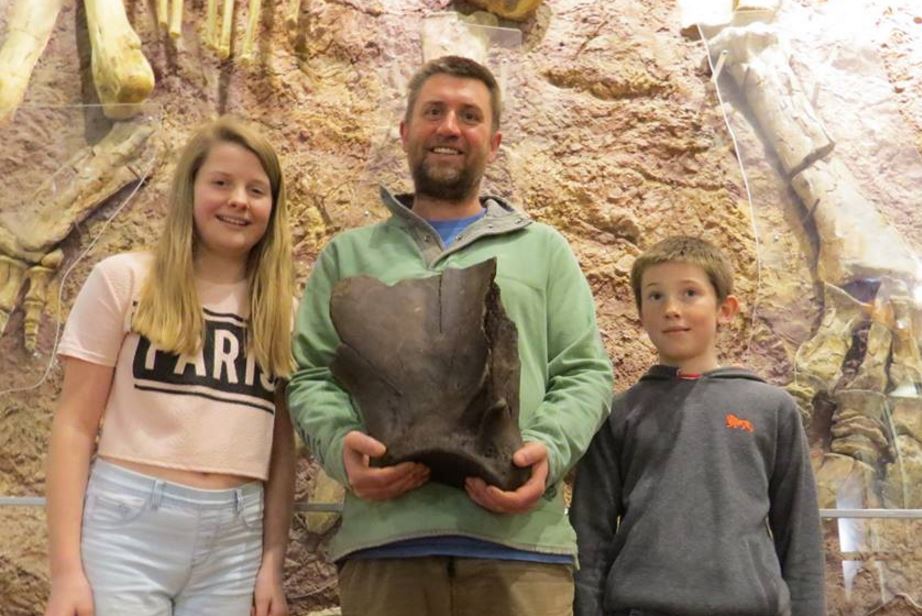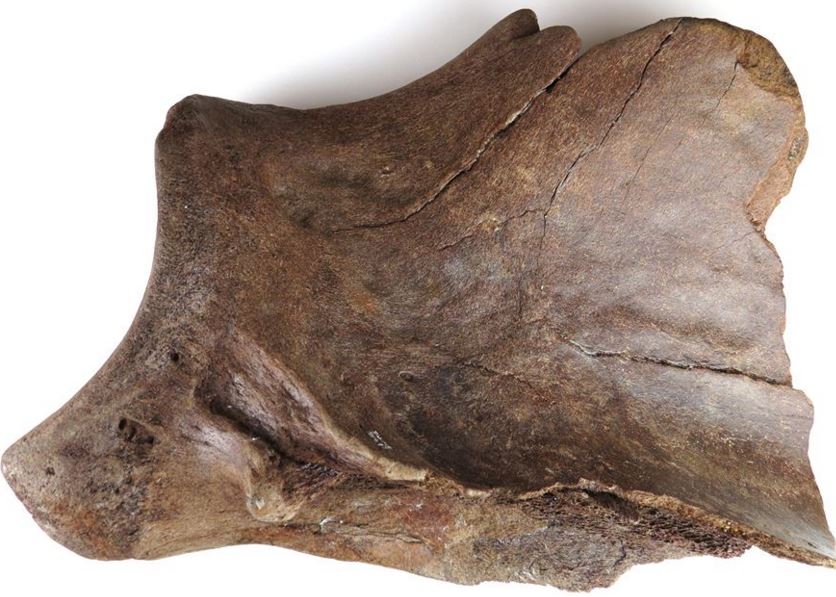An extinct elephant fossil is on display at the Dinosaur Isle museum in Sandown, Isle of Wight. The shoulder bone of the Palaeoloxodon antiquus, also called the Straight-Tusked Elephant, that existed about 100,000 year ago, was closely related to the modern Asian elephant.
Palaeoloxodon antiquus inhabited Europe during the Middle and Late Pleistocene. This particular specimen is believed to date from the Eemian interglacial period, the second-to-latest interglacial period of the current Ice Age.
Paul Hollingshead, a resident of Sandown, a seaside resort town, found the shoulder bone (scapula) of the extinct elephant protruding from the sand in March last year.
 Paul Hollingshead, who found the extinct elephant shoulder bone fossil, accompanied by Lilly Hollingshead (left) and Shay Hollingshead. (Image: Facebook)
Paul Hollingshead, who found the extinct elephant shoulder bone fossil, accompanied by Lilly Hollingshead (left) and Shay Hollingshead. (Image: Facebook)
Dinosaur Isle quoted Mr. Hollingshead on Facebook as saying:
“I had gone down to the beach to look for lead weights to melt down and make new ones out of. It was a big five metre tide so I knew the water would go out a long way, and was looking in amongst the gulleys when I saw a bit of bone showing.”
“I stopped and realised it was a bit bigger than I thought so I started clearing all of the sand and stones away from it, I had to get a piece of wood from the top of the beach to help dig it out. I was shocked how big it was; I spent around two and a half hours digging it out.”
“I was hoping it was a dinosaur bone so was quite shocked to find out what it is. I was pleased to donate it and look forward to seeing it on display.”
Fossil underwent a long conservation process
It has taken the museum over nine months to conserve the specimen so that it was fit to be displayed.
According to the museum:
“Due to the fossil being quite young (in geological terms 110 thousand years really is nothing) full remineralisation (changing of the bone into a more stable material) has not yet occurred. Because of this the remains have been going through long conservation processes to help hold them together.”
 The actual shoulder bone (scapula) of the extinct elephant before it went on display. (Image: Facebook)
The actual shoulder bone (scapula) of the extinct elephant before it went on display. (Image: Facebook)
Museum staff said it was strange to imagine animals we generally associate with living in the much warmer climates of Africa and Asia existing in the wild on the Isle of Wight until relatively recently.
Bison, Hippos and Elephants once inhabited the Isle of Wight
When Palaeoloxodon antiquus was around, Bison and Hippos also existed in the Isle of Wight.
About one million years ago, elephants would have been able to walk to England. It was much colder then, and water that is now in the sea was locked up on land as ice, making the North Sea a vast marshland.
 A reconstruction of Palaeoloxodon antiquus or Straight-Tusked Elephant, the animal experts believe the scapula came from. (Image: Facebook)
A reconstruction of Palaeoloxodon antiquus or Straight-Tusked Elephant, the animal experts believe the scapula came from. (Image: Facebook)
It was only 7,000 years ago that the Isle of Wight became an island, which was the habitat of several exotic creatures until relatively recently.
The museum wrote: “We are incredibly grateful to Paul for his very generous donation.”
